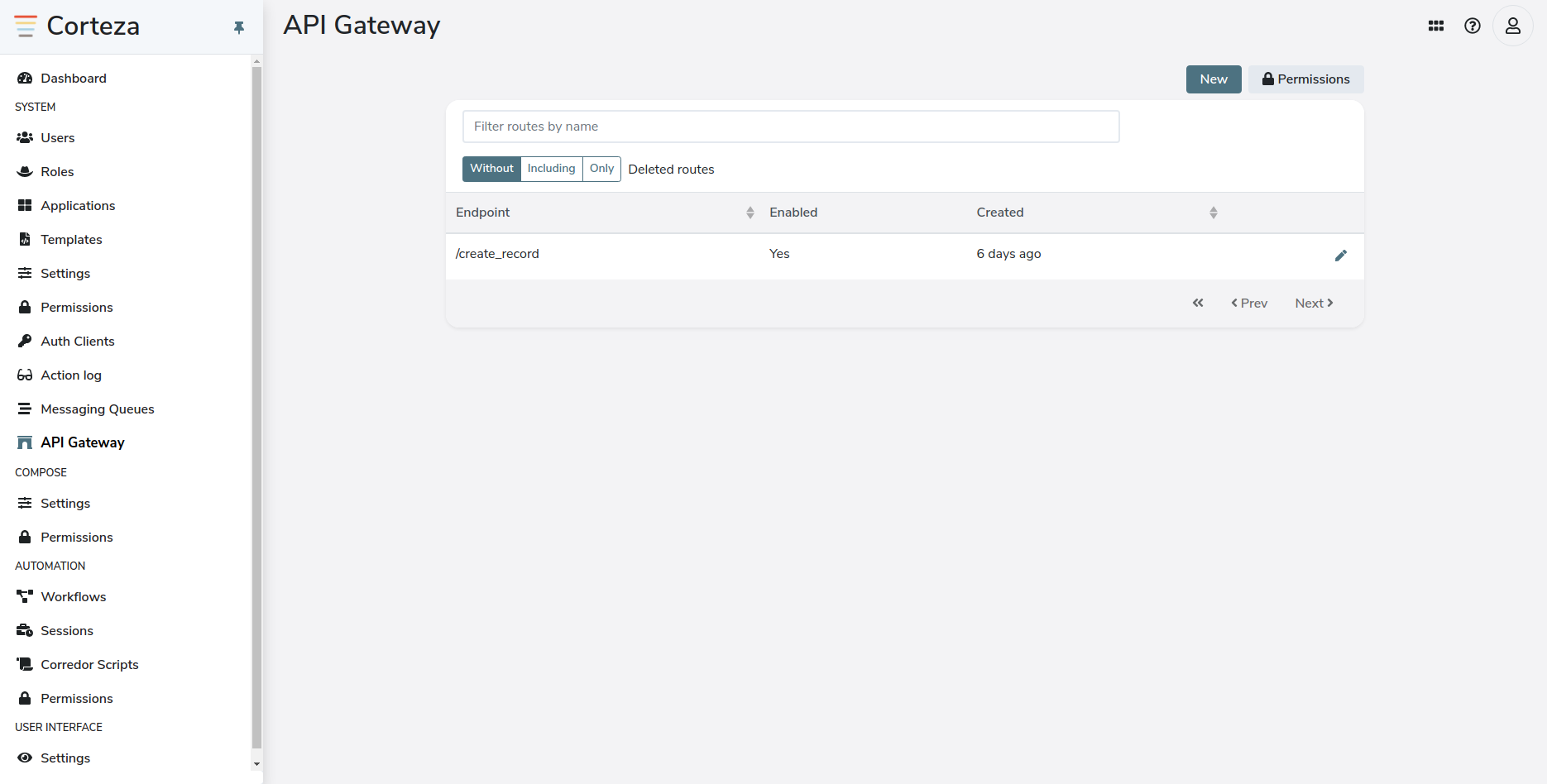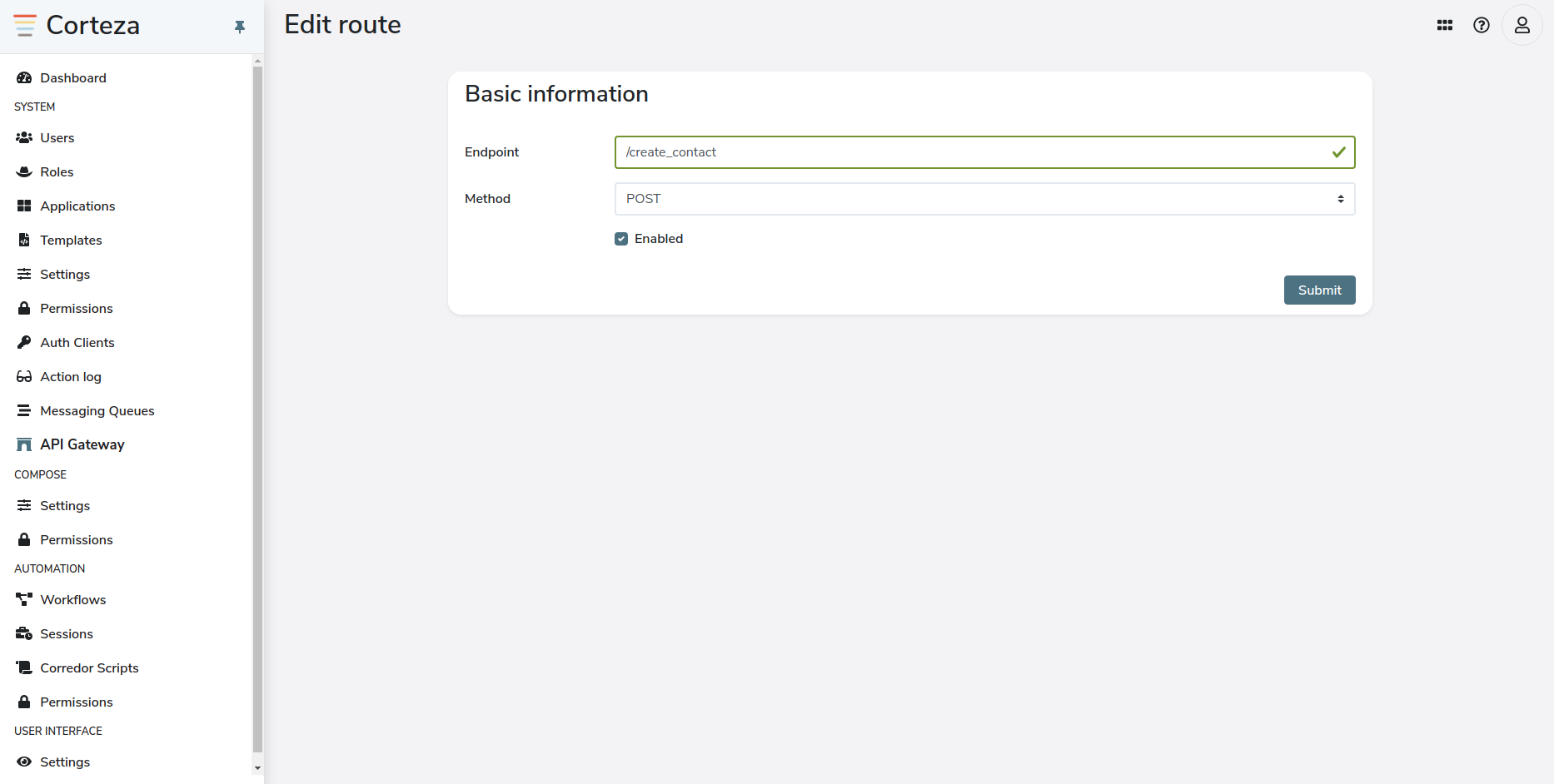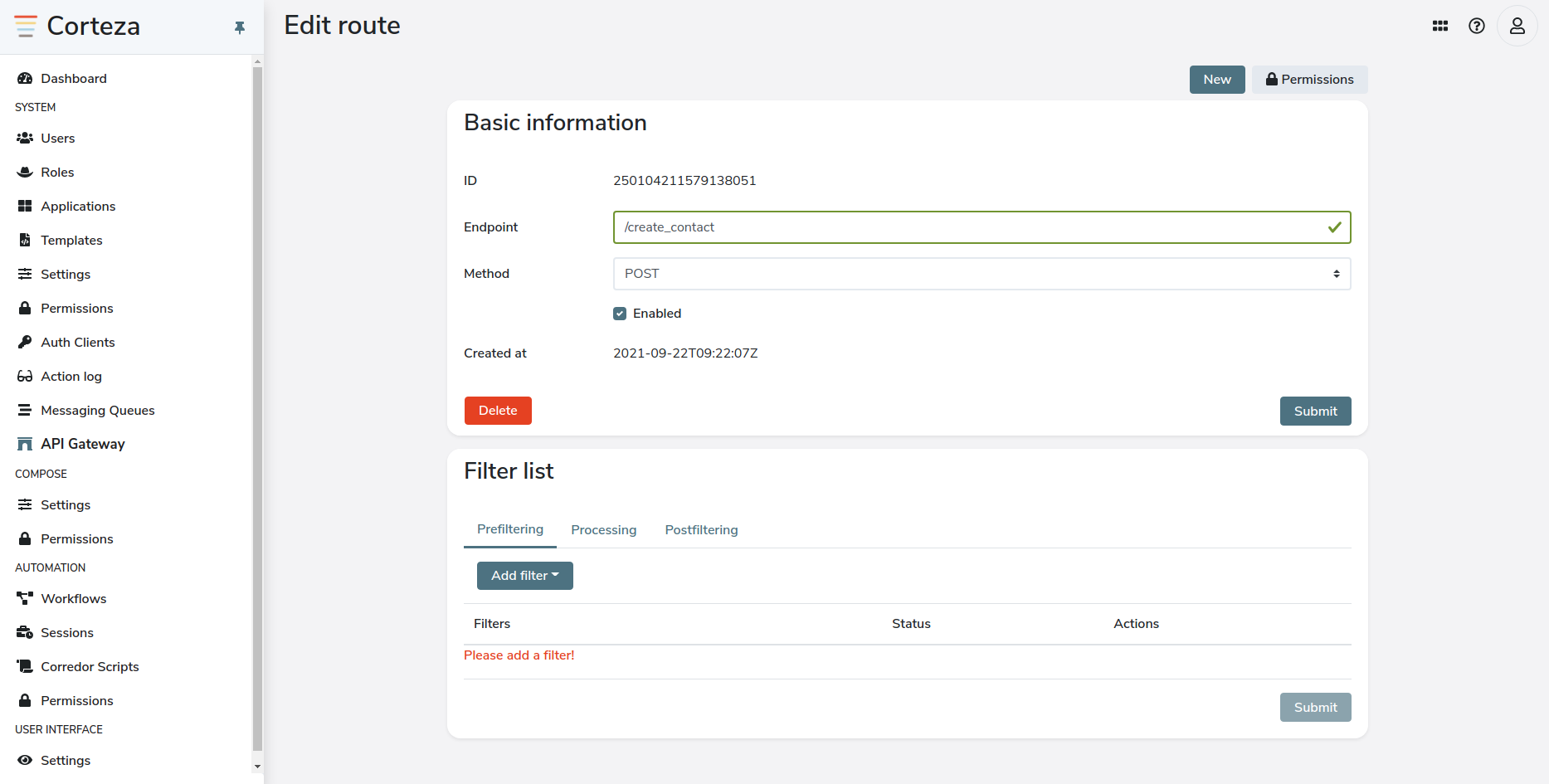Integration Gateway
The Integration gateway facility allows you to define custom endpoints that can support custom authentication methods, request validation, and rate limiting.
These endpoints can be used to define custom endpoint for incoming webhooks, to process data provided by some external integration, or to proxy requests to another service.
Most of the basic operations can be achieved with the built-in functionality; more advanced operations can be implemented with simple JavaScript code snippets or workflows.
Defining a new endpoint
To define a new endpoint, navigate to your Corteza instance (for example http://latest.cortezaproject.org/) and click on the "admin area" application.

In the admin area, navigate to the sub-page. From the admin area you can create and update your endpoints, as well as manage their access control.

When you click on the new button, a new screen will appear where you need to provide the base parameters of your endpoint.

-
endpoint defines the path for the endpoint,
-
method defines what HTTP method the endpoint will listen for.
The endpoint will be accessible under $BASE_URL/api/gateway$YOUR_ENDPOINT.
To exemplify; the /test-api endpoint for the https://latest.cortezaproject.org instance is available under https://latest.cortezaproject.org/api/gateway/test-api
|
You can specify different HTTP methods on the same route, but they need to be specified as different endpoints, ie. GET /customer and PUT /customer being two different integration gateway endpoints. |
When you submit the forum, an additional "filter list" section opens below the base parameters. These filters allow you to validate and process requests; as well as defining the response.
Later sections go more in depth regarding specific filters, what they do, and how they should be used.

Endpoint filters
Filters allow you to validate and process requests; as well as define the response.
|
Each endpoint can define at most one filter of the given type. |
Prefilter
Prefilters allow you to validate the request to determine if the given endpoint should process it. With prefilters, you can implement custom authentication and validation methods.
|
It is currently not possible to use the built-in authentication facility to authenticate requests. This will be added in the future. |
The query parameters prefilter allows you to define a condition which asserts if the request can be processed by this endpoint based on the query parameters. The query parameters are passed into the expression evaluation engine as they were provided.
To examplify; the following query parameters Refer to the expression reference for details regarding writing these expressions. The following example checks if the given HTTP request defines the Endpoint definition:
An example of an HTTP request that conforms to the filter:
An example of an HTTP request that does not conform to the filter:
|
|||||
The header prefilter allows you to define a condition which asserts if the request can be processed by this endpoint based on the request’s headers. All system defined headers are passed into the expression evaluation engine as provided.
User-define headers will automatically be converted into the The following header Refer to the expression reference for details regarding writing these expressions. The following example checks if the given HTTP request defines the Endpoint definition:
An example of an HTTP request that conforms to the filter:
An example of an HTTP request that does not conform to the filter:
|
Processing
A processor defines the core business logic that the endpoint performs. Corteza allows you to process arbitrary payloads, such as a structured JSON or a binary attachment.
Most of the basic operations can be achieved with the built-in functionality; more advanced operations can be implemented with simple JavaScript code snippets or workflows.
The workflow processor allows you to bind a workflow to the endpoint. Refer to the workflow processing for details regarding the interaction. |
|
The payload processor allows you to handle the request’s payload with the help of JavaScript. Refer to the JavaScript processing section for more details. |
Postfilter
Postfilters allow you to finalize the request lifecycle depending on the result of the processing.
The redirect postfilter enriches the response payload with the required redirect HTTP headers. |
|
The JSON response postfilter enriches the response headers with the |
JavaScript request processing
The API GW processing filter includes support to process the request using arbitrary JavaScript code.
|
DevNote what restrictions does Goja implement? |
The provided JavaScript code is automatically wrapped by a function with the signature of:
function (input: Scope): unknown {
// {{snippet}}
}To examplify; the code snippet of return "Hello, World!" would become:
function (input) {
return "Hello, World!"
}The following example code snippet takes in the provided name and surname of our users and returns an array of fullname parameters.
// We firstly need to get the body of the request
var b = JSON.parse(readRequestBody(input.Get('request').Body));
return {
// Assure correct casing
"results":
b.map(function({ name, surname }) {
return {
"fullname": name[0].toUpperCase() + name.substring(1) + " " + surname[0].toUpperCase() + surname.substring(1)
}
}),
"count": b.length
};The following cURL example invokes the above JavaScript function.
curl -X GET $BASE_URL/api/test-js \
-H "Content-Type: application/json" \
-d "[{\"name\":\"johnny\", \"surname\":\"mnemonic\"},{\"name\":\"johnny\", \"surname\":\"knoxville\"}]";Function arguments
The code snippet receives a single argument, input, that contains the entire request.
interface {
Set: (k: string, v: unknown) => void;
Get: (k: string) => unknown;
}The entire HTTP request object. Refer to the GO documentation for detils regarding the signature. |
|||
Integration gateway configuration. Refer to the source for details.
|
|||
The string encoded request body content.
The content is extracted from |
Function result
The result of the JavaScript snippet is provided to the post filters that prepare and return an HTTP response.
When the result is a string, such as Hello, World!, the result is used as is.
When the result is a non-string value, such as { key: "value" }, the result is JSON encoded.
Debugging
System logs
Enable debug logging in your .env file.
Refer to the DevOps guide for details.
Inspecting docker logs
By default, Corteza logs are accessible via Docker logs. To access these logs, you need to firstly navigate to the directory where your Corteza instance resides in.
cd /opt/deploy/{CORTEZA_INSTANCE}/You can use the docker-compose logs server command to access the logs outputted by the server.
|
Refer to the |
docker-compose logs -f --tail=20 server
server_1 | 12:53:14.862 DEBUG rbac rbac/service.go:102 allow delete for corteza::compose:record/245030892240891907/245030893465497603/246932114543603715 {"bypass": [], "context": [], "common": [245030892072923139], "authenticated": [245030891334791171], "anonymous": [], "identity": 250804535289769987, "indexed": 63, "rules": 420}You can also use grep or log filtering to show only specific logs.
Refer to the DevOps guide for details regarding logging.
grep to show only debug logs:user@server:/opt/deploy/{CORTEZA_INSTANCE}/$ docker-compose logs -f --tail=20 server | grep DEBUG
server_1 | 13:52:29.636 DEBUG rbac rbac/service.go:102 allow triggers.manage for corteza::automation:workflow/248229091554160643
Last updated 2021-09-27 18:01:45 +0200
Some content has been disabled in this document